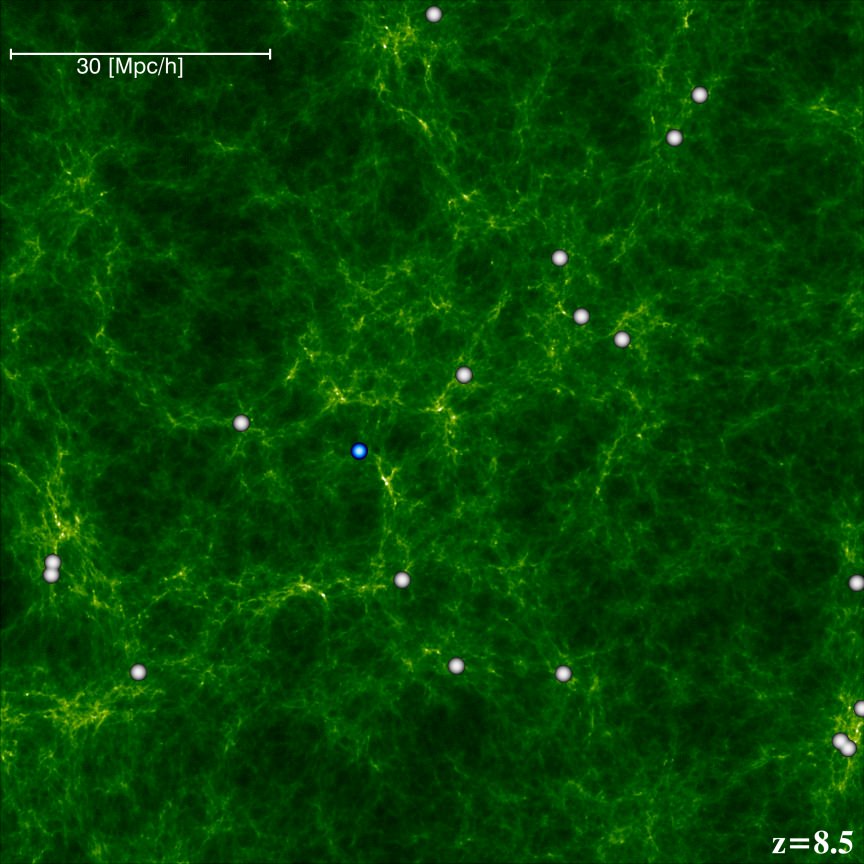[/caption] What did the Universe look like early in its history, only 500 million years after the Big Bang? Currently, we have no way of actually "looking" back that far with our telescopes, but cosmologists from Durham University in the UK have used a computer simulation to predict how the very early Universe would have appeared. The images portray the "Cosmic Dawn," and calculate the formation of the first big galaxies. The simulation also attempts to discern the role that dark matter played in galaxy formation. "We are effectively looking back in time and by doing so we hope to learn how galaxies like our own were made and to understand more about dark matter," said Alvaro Orsi, lead author of the study from Durham University's Institute for Computational Cosmology (ICC). "The presence of dark matter is the key to building galaxies – without dark matter we wouldn't be here today."
In the images produced by the computer simulation, the green swirls represent dark matter, which the scientists say is an essential ingredient in galaxy formation, while the circles show the star formation rate in galaxies. The different color circles represent the varying luminosity of star formation with yellow being brightest. The top image portrays the Universe as it was 590 million years after the Big Bang, and the image below shows the Universe 1 billion years after the Big Bang, as star formation rates begin to ramp up. [caption id="attachment_25167" align="aligncenter" width="580" caption="The Universe 1 billion years after the Big Bang. Credit: Alvaro Orsi, Institute for Computational Cosmology, Durham University."]
[/caption] The very first galaxies were created from the debris of massive stars which died explosively shortly after the beginning of the Universe. The Durham calculation predicts where these galaxies appear and how they evolve to the present day, over 13 billion years later. Although the galaxies today are bigger, they are not forming stars as quickly now as they were in the past. "Our research predicts which galaxies are growing through the formation of stars at different times in the history of the Universe and how these relate to the dark matter," said co-author Dr. Carlton Baugh. "We give the computer what we think is the recipe for galaxy formation and we see what is produced which is then tested against observations of real galaxies."
The massive simulation shows how structures grow in dark matter with a model showing how normal matter, such as gas, behaves to predict how galaxies grow. Gas feels the pull of gravity from dark matter and is heated up before cooling by releasing radiation and turning into stars. The simulation images show which galaxies are forming stars most vigorously at a given time. The image below shows the Universe 1.9 billion years after the Big Bang, a very active time of star formations in galaxies. [caption id="attachment_25168" align="aligncenter" width="580" caption="The Universe 1.9 billion years after the Big Bang. Credit: Alvaro Orsi, Institute for Computational Cosmology, Durham University."]
[/caption] The calculations of the Durham team, supported by scientists at the Universidad Catolica in Santiago, Chile, can be tested against new observations reaching back to early stages in the history of the Universe almost one billion years after the Big Bang. Professor Keith Mason, Chief Executive of the Science and Technology Facilities Council, said: "Computational cosmology plays an important part in our understanding of the Universe. Not only do these simulations allow us to look back in time to the early Universe but they complement the work and observations of our astronomers."
This image shows the Universe today, 13.6 billion years after the Big Bang. Galaxies are not forming stars as quickly now as they were in the past.
[caption id="attachment_25169" align="aligncenter" width="580" caption="The Universe today. Credit: Alvaro Orsi, Institute for Computational Cosmology, Durham University."]
[/caption] The team hopes that further study and simulations of effects of dark matter on galaxies will help astronomers learn more about what this ubiquitous substance is.
Source:
Science and Technology Facilities Council
Institute for Computational Cosmology, Durham University
Department of Physics, Durham University
 Universe Today
Universe Today
